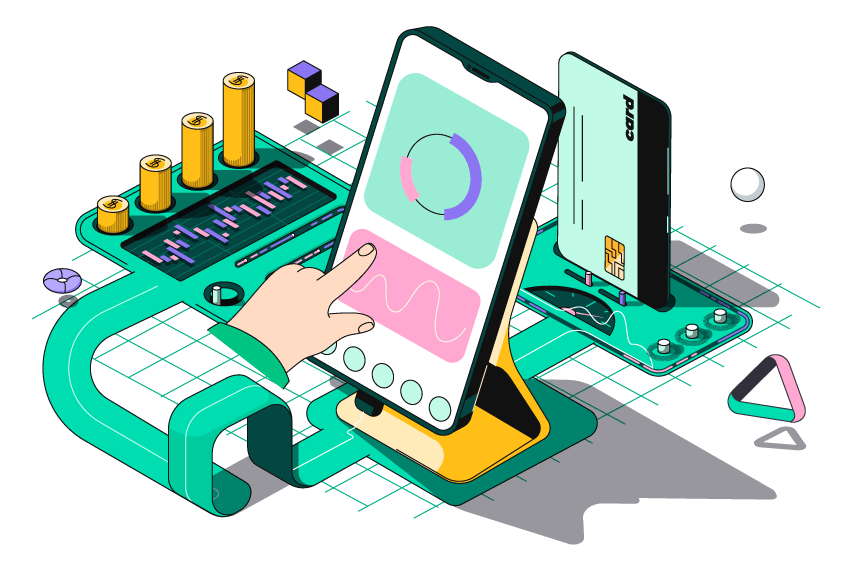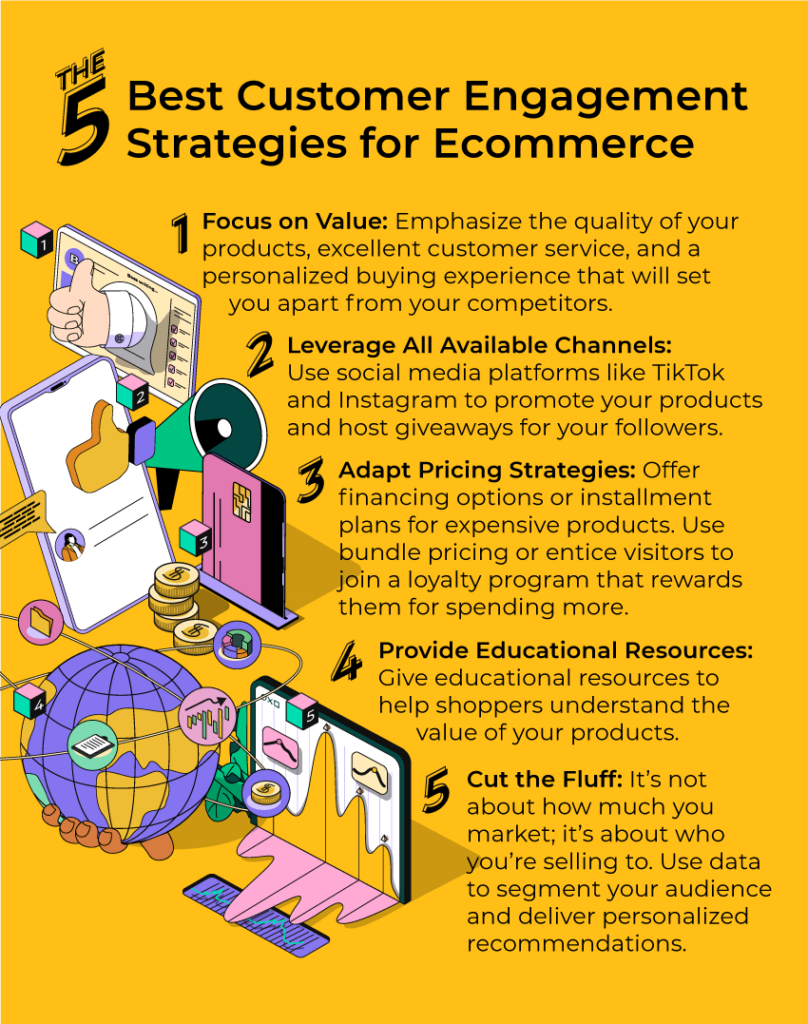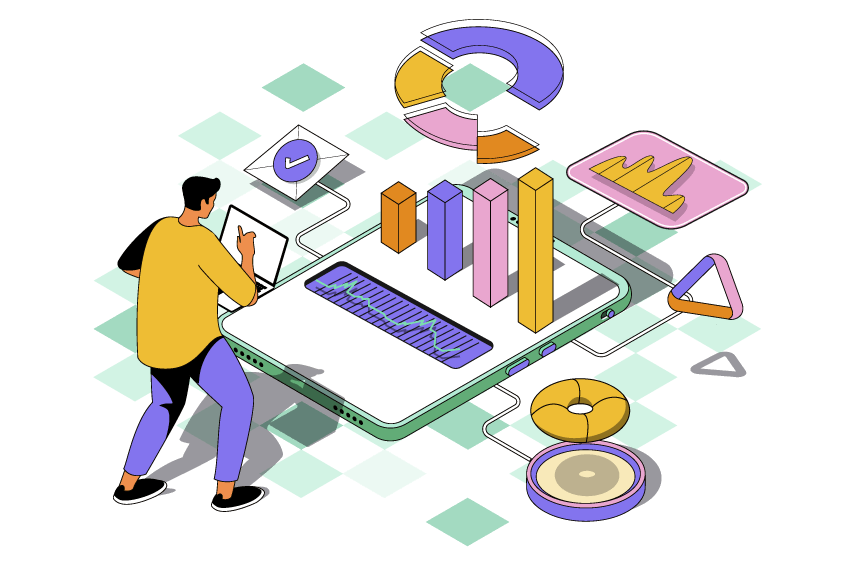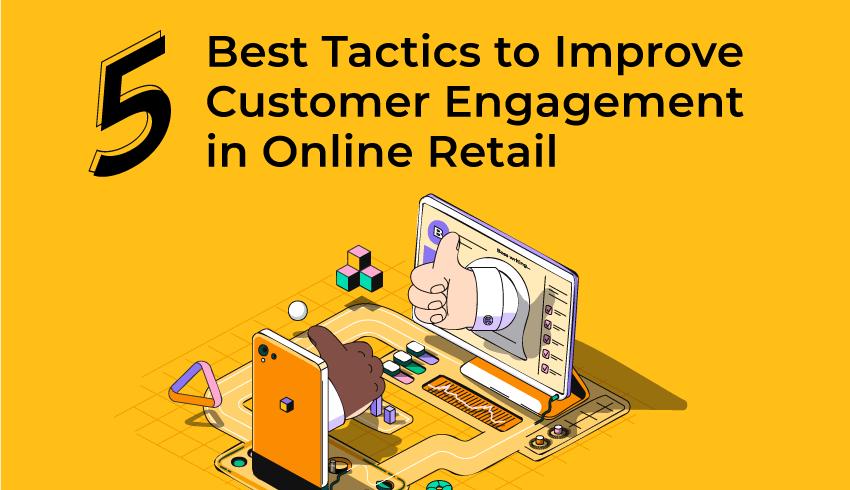The retail landscape is evolving faster than ever, creating exciting opportunities for brands ready to adapt and innovate. While economic headlines might paint a cautionary picture, the reality is that consumer spending remains resilient, particularly in ecommerce where convenience and personalization drive continued growth.
Today’s consumers are making thoughtful decisions about where they spend their money, prioritizing brands that deliver genuine value and meaningful experiences. Research shows they’re particularly drawn to categories that enhance their lives – from health and wellness products to innovative technology solutions. This shift in spending habits creates unique opportunities for ecommerce brands who understand how to connect with their customers.
The key to success in this environment lies in customer engagement – building authentic relationships that transform one-time buyers into loyal brand advocates. With 71% of customers now expecting personalized interactions and 84% more likely to stick with brands offering strong loyalty programs, the importance of effective engagement strategies cannot be overstated.
Digital commerce continues to claim a larger share of retail spending, with mobile shopping and social commerce leading the way. Brands that master the art of customer engagement across these channels are seeing remarkable growth, even in challenging economic conditions. The opportunity lies in understanding and implementing the right strategies to connect with your target audience.
In this guide, we’ll explore proven customer engagement strategies that help ecommerce brands thrive. From creating compelling value propositions to leveraging AI-powered personalization, these approaches will help you build stronger customer relationships and drive sustainable growth. Let’s dive into the specific tactics that can transform your customer engagement and boost your bottom line.
What is Customer Engagement in Retail?
Customer engagement goes far beyond simple transactions – it’s about creating meaningful connections between brands and customers across every interaction point. From website visits and social media interactions to customer support conversations, true engagement builds lasting relationships that turn one-time buyers into loyal brand advocates.
In today’s digital-first world, customers have high expectations for their shopping experiences. Research from McKinsey shows that 71% of customers now expect personalized interactions with brands. This means retailers need to understand and respond to individual customer preferences, shopping habits, and communication styles. The payoff for getting this right is significant – 84% of consumers say they’re more likely to stay with brands that offer customer loyalty programs.
Success in retail customer engagement requires a strategic approach that spans multiple channels while maintaining consistency. This includes coordinating experiences across digital platforms like websites and apps, physical stores, marketing messages, and support interactions. The most effective engagement strategies use data-driven personalization, targeted communication, and loyalty programs to create emotional connections with customers. When done right, these efforts transform casual shoppers into passionate brand supporters who make repeat purchases and recommend your brand to others.
Customer Engagement Trends in 2025
The retail landscape has transformed dramatically in recent years, shaped by technological advances and changing consumer expectations. Today’s customers demand more than just products – they want personalized, efficient, and meaningful interactions across every touchpoint with your brand.
- AI-Powered Personalization at Scale
- Unified Shopping Experiences
- Smart Conversational Support
- Customer-Led Interactions
- Innovative Loyalty Programs
- Data-Driven Decision Making
- AI for Routine Tasks
AI-Powered Personalization at Scale
AI technology now enables brands to analyze vast amounts of customer data and create uniquely tailored experiences for each shopper. This goes beyond simple product recommendations – AI systems can customize everything from email content to website layouts based on individual customer preferences and behaviors.
Unified Shopping Experiences
Customers move seamlessly between social media, mobile apps, email, and physical stores. The most successful brands create consistent, connected experiences across these channels. When a customer starts shopping on Instagram, continues on your website, and finishes their purchase in-store, they expect their preferences and history to follow them.
Smart Conversational Support
AI-powered chatbots and virtual assistants have evolved to handle complex customer interactions with remarkable precision. These tools now offer instant, personalized responses around the clock, dramatically improving customer satisfaction while reducing support costs.
Customer-Led Interactions
The days of one-way marketing messages are over. Today’s consumers drive their own shopping experiences through conversational AI, asking questions and receiving custom recommendations based on their specific needs. This shift puts customers in control of their buying journey.
Innovative Loyalty Programs
Smart brands focus more on keeping existing customers than chasing new ones. Modern loyalty programs go beyond point systems, offering personalized perks, exclusive experiences, and community benefits that match each customer’s preferences and shopping patterns.
Data-Driven Decision Making
Companies now build comprehensive data strategies to understand customer behavior at a granular level. This deep insight enables precise personalization and helps brands anticipate customer needs before they arise.
AI for Routine Tasks
Consumers increasingly prefer AI assistance for simple interactions like checking order status or finding product information. This preference has made AI support a must-have feature for competitive retailers.
Customer Engagement & Spending Habits

The retail landscape has shifted dramatically, with Gen Z and Millennials now wielding significant purchasing power and reshaping how brands connect with customers. These young consumers, with Gen Z alone commanding $450 billion in buying power, are setting new standards for how businesses must operate in the digital age. They’re tech-savvy, mobile-first shoppers who expect seamless experiences across all channels.
What makes these consumers unique is their approach to brand relationships. Research shows that 64% of Gen Z customers will pay more for brands they feel connected to, while both Gen Z and Millennials frequently make impulse purchases (74% and 63% respectively). This spending behavior isn’t random – it’s driven by authentic brand connections, peer recommendations, and social proof. The rise of social commerce, projected to reach $1.2 trillion by 2025, demonstrates how shopping has become deeply integrated with social experiences.
Mobile commerce has become the primary shopping channel, with 80% of global consumers using smartphones to access retail websites even while in physical stores. This shift has pushed brands to adapt, leading to innovations in augmented reality shopping experiences and flexible payment options. The popularity of Buy Now, Pay Later services, particularly among Gen Z where 55.1% use such options, shows how payment flexibility can drive engagement and sales.
These trends point to a clear direction for retail success: brands must create integrated, technology-driven experiences that feel personal and authentic. Whether through AI-powered personalization, social commerce integration, or sustainable practices, the key is meeting customers where they are – on their phones, on social media, and in their values. The brands that understand and adapt to these evolving consumer preferences are the ones that will thrive in today’s competitive market.
The Customer Engagement Lifecycle
Modern ecommerce success depends on understanding and optimizing each stage of customer interaction. From the first touch to becoming a brand advocate, every step presents unique opportunities to deepen customer relationships and drive business growth.
- Discovery and First Impressions
- Early Engagement
- Purchase Decision
- Building Loyalty
- Creating Advocates
Discovery and First Impressions
The journey begins when potential customers first encounter your brand. This crucial first touchpoint happens through various channels – paid advertising, social media, search results, or word-of-mouth recommendations. Smart brands use AI-powered personalization to create tailored landing pages and product recommendations that match visitor interests from the very first click.
Successful discovery requires a strategic mix of targeted outreach and organic visibility. Brands combine SEO optimization, social proof through customer reviews, and data-driven advertising to ensure potential customers see relevant content that resonates with their needs. The goal is to make that first impression count by showing visitors you understand and can solve their specific problems.
Early Engagement
Once customers show interest, the focus shifts to nurturing that initial connection through personalized experiences. Smart retailers analyze browsing patterns and behavior to customize product recommendations, content delivery, and communication timing. Every interaction is an opportunity to demonstrate value and build trust.
This stage requires careful balance – too little engagement loses customer interest, while too much can feel overwhelming. Successful brands use data-driven insights to find the sweet spot, delivering perfectly timed communications and tailored shopping experiences that keep customers moving naturally toward purchase decisions.
Purchase Decision
The conversion stage transforms interest into action through a seamless buying experience. Modern consumers expect frictionless checkout processes with multiple payment options, transparent shipping policies, and clear communication about what happens next. Smart brands remove barriers to purchase by anticipating and addressing common concerns before they become obstacles.
During this critical phase, data-driven insights power personalized promotions and cross-sell recommendations that feel helpful rather than pushy. The focus stays on making customers feel confident in their decisions through clear product information, social proof, and easily accessible support when needed.
Building Loyalty
After the first purchase, attention shifts to exceeding customer expectations and encouraging repeat business. This begins with proactive communication about order status and delivery updates, then extends to personalized follow-ups that help customers get maximum value from their purchases through product care guides and usage tips.
Successful loyalty building requires understanding each customer’s preferences and purchase patterns. Brands use this insight to create personalized experiences through targeted content, exclusive offers, and loyalty programs that reward ongoing engagement. The goal is making customers feel valued and understood at every interaction.
Creating Advocates
The final stage transforms satisfied customers into passionate brand ambassadors who drive new customer acquisition. This happens through carefully crafted loyalty programs, exclusive access opportunities, and community engagement initiatives that make customers feel like valued partners in your brand’s success.
Successful advocacy programs give customers compelling reasons to share their positive experiences. This might include referral rewards, opportunities to provide product feedback, or early access to new releases. The key is creating genuine enthusiasm that naturally spreads through word-of-mouth, powered by authentic customer satisfaction rather than artificial incentives.
The 5 Best Customer Engagement Strategies for Ecommerce
The digital retail landscape continues to evolve rapidly, with customer expectations reaching new heights. These five proven strategies help brands create meaningful connections and drive growth, even in challenging economic conditions.

Focus on Value Creation
In today’s market, competing on price alone isn’t sustainable. Smart brands focus on creating and communicating value through premium product quality, exceptional service, and unique customer experiences. This value-first approach builds stronger customer relationships that withstand price sensitivity.
Success comes from consistently demonstrating your brand’s unique value proposition across every touchpoint. Whether through detailed product storytelling, superior customer support, or personalized shopping experiences, make it clear why choosing your brand is worth the investment.
Build an Integrated Channel Strategy
Modern customers move fluidly between social media, mobile apps, email, and websites. Brands need a cohesive presence across all these channels, ensuring consistent messaging and seamless experiences. This integration becomes even more critical as social commerce and mobile shopping continue to dominate consumer behavior.
The key is maintaining authenticity while adapting content for each platform’s unique characteristics. From TikTok’s short-form videos to Instagram’s shoppable posts, each channel offers distinct opportunities to engage customers and drive conversions while maintaining a unified brand voice.
Smart Pricing and Payment Innovation
Today’s consumers expect flexible payment options that match their preferences and financial situations. Beyond traditional discounting, successful brands offer innovative solutions like subscription models, bundled packages, and “buy now, pay later” options that make purchases more accessible.
These approaches maintain profit margins while providing customers with payment flexibility they value. By combining these options with strategic loyalty programs, brands can increase average order value and customer lifetime value simultaneously.
Content That Drives Decisions
Modern customers research extensively before purchasing, seeking information that justifies their buying decisions. Successful brands create comprehensive content ecosystems that educate and inform, from detailed product specifications to sustainability credentials and usage guides.
This educational approach builds trust and positions your brand as an authority in your space. When customers understand the full value of your products – from materials and manufacturing to long-term benefits – they’re more likely to make confident purchase decisions.
Data-Driven Personalization
AI and machine learning now enable unprecedented levels of personalization in the shopping experience. Smart brands use customer data to create tailored experiences across every touchpoint, from personalized product recommendations to customized email campaigns and targeted promotions.
The key is using data responsibly to create experiences that feel helpful rather than invasive. By understanding customer preferences, browsing patterns, and purchase history, brands can deliver relevant recommendations and communications that genuinely enhance the shopping experience and drive customer loyalty
Get Started on All of the Above — at No Upfront Cost to You

Here at Nogin, we understand the importance of staying competitive, especially in a tighter economy.
Our enterprise ecommerce solution can help you keep growing and making money regardless of economic conditions. While traditional SaaS leaves you with a messy patchwork of apps that may or may not integrate, Nogin is an all-in-one solution for your brand’s:
- Commerce platform (our tech integrates seamlessly into Shopify Plus)
- Personalization
- Customer Data Platform
- Merchandising
- Marketing
. . . And more!
Best of all, it’s easy (and free) to get started. There are no upfront costs for our services, and our Nogin nerds are here to support you every step of the way.
P.S. Interested in setting up an informative, no-pressure call to learn how Nogin can help you? Schedule a convo today!
Customer Engagement in eCommerce FAQ
What is customer engagement in ecommerce?
Customer engagement in ecommerce refers to the interaction and relationship between a brand and its customers through various touchpoints. It aims to create meaningful experiences that foster loyalty, increase sales, and encourage customers to return.
What strategies can increase customer engagement?
Strategies to increase customer engagement include personalized marketing, providing exceptional customer service, leveraging social media, creating loyalty programs, offering valuable content, and utilizing data analytics to understand and meet customer needs.
What are the three pillars of customer engagement?
The three pillars of customer engagement are personalization, communication, and value. Personalization ensures tailored experiences, communication builds trust and rapport, and value delivers meaningful benefits to customers.
What are the four levels of customer engagement?
The four levels of customer engagement are:
- Awareness – Customers know about your brand.
- Consideration – Customers are evaluating your products.
- Purchase – Customers buy your products.
- Loyalty – Customers repeatedly purchase and advocate for your brand.
How do you deliver customer engagement?
Deliver customer engagement by creating personalized experiences, maintaining consistent communication, offering excellent customer service, providing relevant and valuable content, and utilizing data to anticipate and meet customer needs.
What is the client engagement process?
The client engagement process involves attracting potential customers, converting them into buyers, retaining them through exceptional experiences, and encouraging them to become loyal advocates for your brand.
How do you determine customer engagement?
Customer engagement is determined by tracking metrics such as website traffic, time spent on site, click-through rates, social media interactions, email open rates, purchase frequency, and customer feedback.
What is a customer engagement model?
A customer engagement model outlines the methods and strategies a business uses to interact with customers throughout their journey. It includes tactics for attracting, converting, retaining, and nurturing customers to build long-term relationships.
What are the two types of customer engagement?
The two types of customer engagement are:
- Behavioral engagement – Actions customers take, such as purchases, clicks, and social media interactions.
- Emotional engagement – The feelings and attitudes customers have toward a brand, reflected in loyalty and advocacy.
What is the goal of customer engagement?
The goal of customer engagement is to build strong, lasting relationships with customers that increase loyalty, enhance customer satisfaction, drive repeat purchases, and ultimately boost revenue and brand advocacy.

